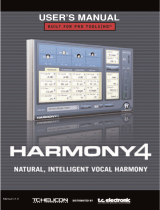
5
Table of Contents
SPEED .......................................... 60
DEPTH ......................................... 60
DUCKING AMOUNT ............................ 60
DUCKING TIME.................................. 60
LEAD to REV .................................... 60
HARM to REV ................................... 60
DEL to REV...................................... 60
LEAD LEVEL..................................... 60
HARDTUNE Tab ...................... 61
HARDTUNE KEY ................................ 61
HARDTUNE RATE ............................... 61
HARDTUNE AMOUNT........................... 61
HARDTUNE SHIFT............................... 61
HARDTUNE WINDOW .......................... 61
KEY & SCALE ................................... 61
NOTE & ENABLED............................... 62
DOUBLE Tab Overview ........................... 63
STYLE .......................................... 63
LEVEL...........................................63
HUMANIZE STYLE ............................... 63
HUMANIZE AMOUNT ........................... 63
V1 to V4 PAN .................................... 63
V1 to V4 LEVEL .................................. 63
V1 to V4 PORTA ................................. 63
V1 to V4 SMOOTHING ........................... 63
V1 to V4 GENDER................................ 63
LEAD LEVEL..................................... 64
CHOIR.......................................... 64
HARMONY Tab Overview .............. 65
STYLE .......................................... 65
LEVEL...........................................65
V1 to V4 VOICING................................ 65
V1 to V4 LEVEL .................................. 65
V1 to V4 GENDER................................ 65
V1 to V4 PAN .................................... 65
DOUBLING and DOUBLE LEVEL .................. 65
CHOIR, CHOIR LEV and CHOIR STYLE ............. 65
HUMANIZE STYLE ............................... 66
HUMANIZE AMOUNT ........................... 66
VIBRATO STYLE ................................. 66
VIBRATO AMOUNT .............................. 66
V1 to V4 PORTA ................................. 66
V1 to V5 SMOOTHING ........................... 66
GUITAR CHORDS ............................... 67
HOLD RELEASE ................................. 67
TUNING ........................................ 67
HARMONY EQ .................................. 67
LEAD LEVEL..................................... 67
NATURALPLAY .................................. 68
NATURALPLAY Settings and Parameter Changes ..... 69
NATURALPLAY = SCALE Mode ................... 69
KEY & SCALE .................................... 69
EDITING . . . . . . . . . . . . . . . . . . .54
Editing Overview ................................. 54
Navigation ...................................... 54
Saving Changes ................................... 54
THE EDIT BUTTON . . . . . . . . . . . . .55
µMOD Tab Overview .................. 55
STYLE .......................................... 55
LEVEL...........................................55
WIDTH ......................................... 55
DETUNE LEFT / DETUNE RIGHT .................. 55
SPEED ..........................................55
DEPTH-L / DEPTH-R ............................. 55
OUT PHASE..................................... 55
DLY L / DLY R ................................... 55
FEEDBACK L / FEEDBACK R ....................... 55
PHASE ......................................... 55
WAVE .......................................... 56
XFB L / XFB R ................................... 56
LOWCUT L / LOWCUT R & HICUT L / HICUT R.... 56
LEAD To UMOD ................................. 56
HARM To UMOD ................................ 56
LEAD LEVEL..................................... 56
DELAY Tab Overview................... 57
STYLE .......................................... 57
LEVEL...........................................57
WIDTH ........................................ 57
SOURCE ........................................ 57
TEMPO ......................................... 57
DUCKING....................................... 57
DIV L / DIV R .................................... 57
TIME L / TIME R .................................. 57
FEEDBACK L / FEEDBACK R ...................... 58
XFB R TO L / XFB L TO R ......................... 58
LOCUT L / LOCUT R & HICUT L / HICUT R ........ 58
DUCKING AMOUNT ............................ 58
DUCKING TIME.................................. 58
LEAD TO DELAY ................................. 58
HARM TO DELAY ................................ 58
UMOD TO DELAY ............................... 58
LEAD LEVEL..................................... 58
REVERB Tab Overview.................. 59
STYLE .......................................... 59
LEVEL...........................................59
WIDTH ........................................ 59
DECAY ......................................... 59
LO COLOR / HI COLOR ......................... 59
HI FACTOR...................................... 59
EARLY REFLECTIONS / TAIL LEVEL ................. 59
DUCKING....................................... 59
DIFFUSE ........................................ 59
PRE DLY ........................................ 60




















